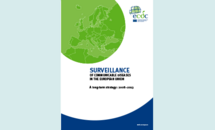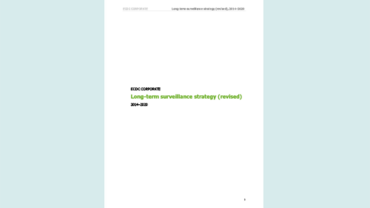Surveillance of communicable diseases in the European Union - A long-term strategy: 2008-2013
This long-term vision and strategy on the future surveillance of communicable diseases in the EU has been developed to help direct the decisions for the long-term development of the European surveillance system.
Executive Summary
This strategy covers the years until 2013, which aligns it with ECDC’s multi-annual strategic plan (approved by the ECDC Management Board in June 2007). Moreover, synergetic effects with ECDC’s laboratory strategy are foreseen.
The strategy attempts to define the terms and scope of surveillance, its aims and objectives, and its organisational requirements. It also outlines ways to support the Member States and presents an implementation roadmap.
The overall goal is to contribute to reducing the incidence and prevalence of communicable diseases in Europe by providing relevant public health data, information and reports to decision makers, professionals and health care workers in an effort to promote actions that will result in the timely prevention and control of communicable diseases in Europe. High validity and good comparability of communicable disease data from the Member States are imperative to reach this goal.
A more coordinated approach to surveillance will
- improve the regional comparability of data;
- reduce the complexity in surveillance across Europe;
- allow to tackle surveillance in a synergistic way;
- avoid duplication of work;
- provide better quality public health evidence in the long term, thanks to more relevant and reliable data;
- make it easier to strengthen the national surveillance systems;
- most likely be economically more efficient and sustainable;
- allow easier access to, and use of, the data;
- enhance the detection and monitoring of international outbreaks;
- contribute to capacity building; and
- ensure the inclusion of diseases into surveillance and research agendas according to European priorities.
ECDC is developing a system for infectious disease indicator-based surveillance at the European level, dubbed ‘The European Surveillance System (TESSy)’. TESSy will be a valuable tool to improve the collection, validation, storage and dissemination of surveillance data from the EU Member States and EEA countries. Initially, TESSy will collect a reduced set of core variables important for the routine surveillance of infectious disease cases. Once TESSy is generally accepted and used as the regional standard database, ECDC’s long-term goals of further reducing the complexity and workload for all participants will be supported by
- standardising data collection on infectious disease surveillance;
- providing a ‘one-stop shop’ for reporting and retrieving data for the Member States;
- standardising the reports based on surveillance data; and by
- providing a consistent and easily available overview of the current situation in the EU.
Download







